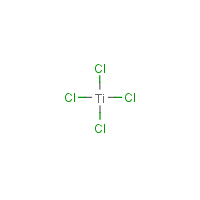Titanium tetrachloride
Agent Name
Titanium tetrachloride
CAS Number
7550-45-0
Formula
Cl4-Ti
Major Category
Toxic Gases & Vapors

Synonyms
Tetrachlorotitanium; Tetrachlorure de titane [French]; Titaantetrachloride [Dutch]; Titane (tetrachlorure de) [French]; Titanic chloride; Titanio (tetracloruro di) [Italian]; Titanium chloride; Titanium chloride (TiCl4); Titanium chloride (TiCl4), (T-4)-; Titanium tetrachloride; Titantetrachlorid [German]; [ChemIDplus] UN1838
Category
Other Toxic Gases & Vapors
Description
A colorless fuming liquid with a pungent odor; [CAMEO]
Sources/Uses
Used to manufacture titanium-containing compounds; used as white pigments in paints; [ATSDR ToxFAQs] Used in chemical vapor deposition to apply coatings to metals and other materials with high melting points--the process involves bubbling hydrogen and nitrogen though a bath of titanium tetrachloride or vanadium tetrachloride. [Scand J Work Environ Health 1991;17:369-79] Used in dyeing textiles and leather (mordant), making glass, and in smoke screens; [AIHA]
Comments
TLV Basis is upper respiratory tract damage. [ACGIH] Can cause pneumonitis; [Table 16.3, Sullivan, p. 213] Liquid causes second degree burns after contact for a few minutes. [CHRIS] Corrosive to skin; [Quick CPC] When TiCl4 comes in contact with water, HCl is rapidly generated. [ATSDR ToxFAQs] See [Park T, et al. Diffuse Endobronchial Polyposis Following A Titanium Tetrachloride Inhalation Injury. Am Rev Respir Dis. 1984 Aug;130(2):315-7] A corrosive substance that can cause injury to the skin, eyes, and respiratory tract; Inhalation may cause pulmonary edema; [ICSC]
Biomedical References
Exposure Assessment
TIH
Yes
Dangerous When Wet
Yes
Ceiling (ACGIH)
0.5 ppm, as HCl
Lethal Concentration
LC50 (rat) = 400 mg/m3
Explanatory Notes
Some “Water Reactive Materials” are also TIH materials themselves: Titanium tetrachloride; [ERG 2016] VP = 1.31X10-2 atm @ 20 deg C; [HSDB]
NFPA
will not burn
ERPG-1
5 mg/m3
ERPG-2
20 mg/m3
ERPG-3
100 mg/m3
WEEL
0.64 ppm
Adverse Effects
Toxic Pneumonitis
Yes
Dermatotoxin
Skin burns
ACGIH Carcinogen
Not Classifiable
Diseases, Processes, and Activities Linked to This Agent
Diseases
Occupational diseases associated with exposure to this agent:
Processes
Industrial Processes with risk of exposure: